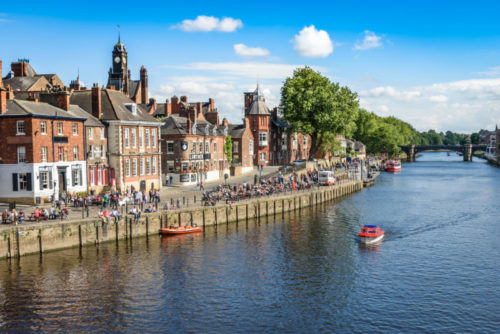Property expert Ashley Mallett is based at our York office and explains what he loves about the area:
In York, it seems that every building has a story to tell with history behind it. Add to that the museums and tours it’s a history lover’s heaven! I love the quirky Tudor/Medieval shops and boutiques, along The Shambles.
The brief history of York
York has an extremely rich history, founded by the Romans in 71AD. The City was conquered by the Viking Danish Army in or around 866 AD and became a shipping port. One of the major changes by the Vikings was the change of the City’s name from Eboracum to Jorvik.
York went through a major economic decline in Tudor Times, largely due to the dissolution of the monasteries by Henry VIII. Shortly after this, York once again became a trading and service centre and many buildings in the City, especially in the Centre.
York became a major railway hub in the late 19th Century. Rowntree’s Cocoa Works and Terry’s set up large factories. In to the 20th century, York’s economy and employment figures were driven by the rail and chocolate industries.
Famous people from York
- Guy Fawkes
- Dame Judi Dench
- Lucy Staniforth
- Jon Champion
York today
Tourism is a major industry in York. Hotspots include The National Railway Museum, Jorvik Viking Centre, The York Dungeon, & York’s Chocolate Story.
York Castle, a former prison, houses a museum. Visitors can walk along the medieval Clifford’s Tower. York Minster towers above the skyline. For a small fee, visitors can enjoy a guided tour of their historic surroundings.
For lovers of The Great Outdoors, the City Walls & the River Ouse makes a great walk.
York great for commuters
York occupies a fantastic location for commuters. Situated conveniently on the A64, Leeds is approximately a 22 mile drive away to the south, and to the north, the quaint seaside resorts of Scarborough, Filey and Whitby are in easy reach.
York is a major railway hub. Newcastle is around 1 hour away by train with Leeds, a mere 20 minutes, making a commute relatively convenient.
Things to consider when buying a Property in York
Whilst not exhaustive, the below information indicates what you should look out for when purchasing property in or around York.
Conservation Area
Due to its historical significance, properties in York & the surrounding areas are likely to fall within a conservation area. Conservation areas are designed to protect areas of significant historical value, from any harmful change, encouraging good quality design in new developments. Any buildings within conservation areas are protected from unauthorised demolition. New development also has to respond to the historic settings. Trees are also protected in conservation areas.
Planning permission is required for certain external works to a house within a conversation area, which wouldn’t normally need planning permission elsewhere. Conservation areas mean extra care, planning controls and considerations if you wish to extend or change your property or garden. This is in keeping with the original historic architectural settings.
Conservation area restrictions will affect any owners who are seeking to work on the outside of their home or garden. The local planning authority is the organisation to seek if you wish to change or adapt your home in a conservation area. They will explain what permissions will be needed.
Flood Risk
The River Ouse has unfortunately in recent times, caused widespread destruction following periods of heavy rainfall. Some properties being categorised as being in a High Flood Risk area, which could make obtaining a mortgage or buildings insurance more difficult. You should be mindful of this when purchasing in the area.
We would strongly recommend that a good quality, reliable Environmental Search is carried out when purchasing in York, especially if the property you are buying is within close proximity to the River Ouse or River Foss. Whilst we cannot comment on the results, we would recommend that where a moderate-high flood risk is found in York, or flooding has occurred in the property you are purchasing, you report this to your proposed Buildings Insurer to ensure that you will still be able to obtain insurance on standard terms.
Particular attention should be paid to the Property Information Form and what the seller has had to say about flooding. This form also gives information on buildings insurance claims, which may have been made as a result of a flood.
Listed Buildings
Due to the historical significance and age of some properties in York, especially in and around the City Centre, you may find that the property you are purchasing is listed.
This means that it has been placed on one of the four statutory lists maintained by Historic England. A listed building may not be demolished, extended or altered without special permission from the planning authority, which normally involves a central Government agency. A National Amenity Society must be notified of any works which involve demolition.
Bridges, monuments, war memorials, sculptures and other such items could be listed and so great care is required. Criminal prosecution can follow for unauthorised works or demolition of a listed building or structure.
The procedure for works to any listing building can be strict and onerous, and so you need to be aware of what you are buying if the property is listed.
We would highly recommend a Local Authority Search to be carried out for all properties within the York & North Yorkshire area, to ensure that we can flag up and advise of any potential listed building status.
If you require any more information regarding property advice, call 01904 917 982 or email Ashley Mallet at Ashley.Mallett@isonharrison.co.uk


















